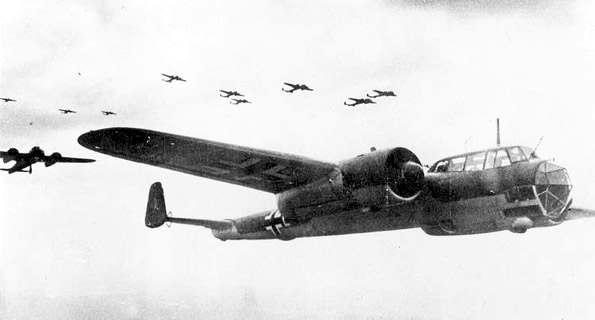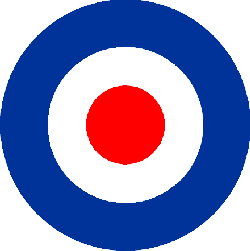|
  During
the Second World War several decoy airfields were constructed under the
Command of Colonel John Turner, Royal Engineers. The reason these
airfields were constructed was to lure the Luftwaffe's bomber aircraft
away from more desirable targets. Known as K sites, they looked extremely
convincing from the air, and in some cases from the ground too! Large
painted sheets were pegged out on the ground to look like hangers and
other buildings normally associated with an airfield, and to complete the
deception life size dummy aircraft, both inflatable and of flat wooden
construction -
LEFT - were used. On some sites
redundant Tiger Moth trainers and old service vehicles such as tenders -
RIGHT
- bomb tractors etc. were parked up to further enhance the overall
impression. The K sites were aimed at deceiving aircraft flying by day but
in order to deceive aircraft flying by night a further degree of deception
was employed in the form of a runway flare path, which operational
airfields had in order to enable it's own aircraft to land in the dark.
Together with other lights dotted about to give the impression of vehicles
and aircrew moving about, the entire deception could prove extremely
attractive to a Luftwaffe bomber crew! These night time dummy airfields
were referred to as Q sites. During
the Second World War several decoy airfields were constructed under the
Command of Colonel John Turner, Royal Engineers. The reason these
airfields were constructed was to lure the Luftwaffe's bomber aircraft
away from more desirable targets. Known as K sites, they looked extremely
convincing from the air, and in some cases from the ground too! Large
painted sheets were pegged out on the ground to look like hangers and
other buildings normally associated with an airfield, and to complete the
deception life size dummy aircraft, both inflatable and of flat wooden
construction -
LEFT - were used. On some sites
redundant Tiger Moth trainers and old service vehicles such as tenders -
RIGHT
- bomb tractors etc. were parked up to further enhance the overall
impression. The K sites were aimed at deceiving aircraft flying by day but
in order to deceive aircraft flying by night a further degree of deception
was employed in the form of a runway flare path, which operational
airfields had in order to enable it's own aircraft to land in the dark.
Together with other lights dotted about to give the impression of vehicles
and aircrew moving about, the entire deception could prove extremely
attractive to a Luftwaffe bomber crew! These night time dummy airfields
were referred to as Q sites.
  One
of these dummy airfields was built on the moors directly overlooking the
B6232 in between the tiny village of Belthorn just outside Blackburn, and
the small mill town of Haslingden a little further to the east, although I
do not know whether it was a K or a Q site. Little remains of the airfield
now, but at the Belthorn end there is still what looks like an air raid
shelter with most of it's roof intact. To the east about 2 miles or so out
of Haslingden, a large bomb crater in the ground reveals that the illusion
must have worked at least once! Close to the crater a large concrete base
plate is all that remains of whatever was constructed at this end of the
decoy airfield. One
of these dummy airfields was built on the moors directly overlooking the
B6232 in between the tiny village of Belthorn just outside Blackburn, and
the small mill town of Haslingden a little further to the east, although I
do not know whether it was a K or a Q site. Little remains of the airfield
now, but at the Belthorn end there is still what looks like an air raid
shelter with most of it's roof intact. To the east about 2 miles or so out
of Haslingden, a large bomb crater in the ground reveals that the illusion
must have worked at least once! Close to the crater a large concrete base
plate is all that remains of whatever was constructed at this end of the
decoy airfield.
The biggest question really is what was
this dummy airfield constructed to protect? Not particularly far away over
on the other side of Blackburn is another airfield - a real one this time
- at Salmesbury - but I suppose it could possibly have been put where it
is to draw attention away from the railway in Blackburn itself. I am not
sufficiently expert in these things to say for sure though my money would
be on it protecting Salmesbury which was associated with an aircraft
production plant at that time, and still is.
In 1990, having had sore feet and
humungous blisters far too many times, and feeling really rather fed up
with the "hurry up and wait"
mentality so endemic in the infantry, I left the 4th. (Volunteer)
Battalion of The Queens Lancashire Regiment, and with Tracy as my 2I.C.,
took over the running of an Army Cadet Detachment in Haslingden.. Between
then and 1998 we often used the shelter on night exercises with the cadets
for an RV or the like, and I have many a fond memory of waiting in the
dark, breathing in the heady aroma of sheep p*ss, and closing one eye
every time a car came past on the road below in order to preserve my night
vision... happy days!
  The
pix!!! The
pix!!!If you want to view any of
the pix in a larger size then click on the small
picture of your choice and it will open a
larger version in a new window... |
|